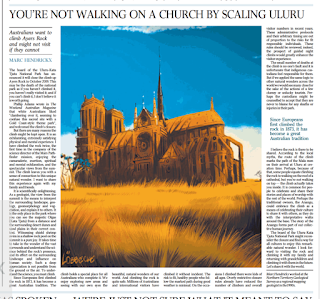My comment piece in The Australian today...
Uluru should be open for all to share the experience
Uluru should be open for all to share the experience
The board of the Uluru-Kata Tjuta National Park has announced it will close the climb up Ayers Rock in October 2019. This may be the death of the national park as if you haven’t climbed it, you haven’t really visited it; and if you can’t climb it, I don’t believe it is worth going.
Phillip Adams wrote in The Weekend Australian Magazine that white Australians liked “clambering over it, seeming to confuse this sacred site with a Gold Coast-style theme park”, and welcomed the climb’s closure.
But there are many reasons the climb might be kept open. It is an exhilarating, extremely satisfying physical and mental experience. I have climbed the rock twice, the first time in the company of the science director of the Mars Pathfinder mission, enjoying the camaraderie, exertion, spiritual and mental exhilaration, and the spectacular views from the summit. The climb leaves you with a sense of connection to this unique natural wonder. I want to share this experience again with my family and friends.
Read the rest via the link. Subscription required, but worth it! (I'll post a longer version soon.).
Copy below:
Copy below:

Comments
Post a Comment